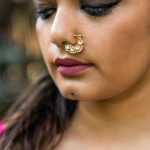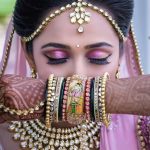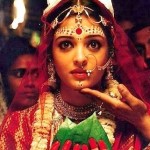The traditional kumkum style bindi patterns in red, white and yellow are synonymous with the traditional Bengali bride. Every Bengali bride can be seen in different beautiful designs of kumkum bindi done on the forehead. It is a custom which is sometimes done in an exaggerated manner which covers the entire forehead and then eventually comes down till cheeks, or is just done a little bit around the Bindi for a more formal look. Earlier when there were no stick on Bindi available, women used to make these beautiful designs using sindoor, chandan basically the natural ingredients for the designs. Afterwards the stick on bindi’s became more popular because they are fast to apply whereas the hand done designs take time because they are elaborate patterns and is done manually. But this tradition is still religiously followed by the bengali brides, it also gives you the liberty of customizing your designs according to your choice.
Undoubtedly, its graceful and looks so traditional, here are few different design patterns of the same…..
– This version covers the entire forehead with a bold design pattern. Colors like white chandan and red kumkum is mixed here for a colorful look. The red bold bindi done in the center, forms the base of the design and the other patterns take shape from here.
– A small and sweet variation which can be tried by the bridesmaid and other relatives. It is also a great choice for the brides who do not wish to experiment with the exaggerated versions. A delicate pattern is done around the bindi for a lighter version.
– Use of glitter can also be done in between to beautify the patterns, glitter in gold and silver can be used according to your choice. A pattern covering only the half forehead is done here.
– One of the most traditional pattern is a dotted one and comes upto cheeks, looks super graceful too.
– This is the most traditional pattern out of all and eventually this was the design followed in ancient times, all other variations are derived from this one. It is done in three parts, one covering the forehead, other covering the cheeks, and the last one done slightly over the chin area.
Image reference: Pinterest






